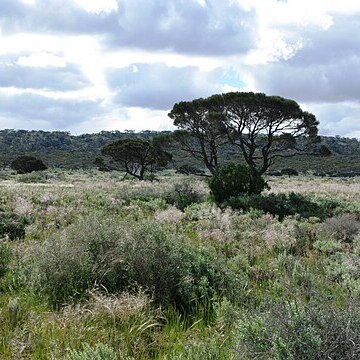Tall shrub or small tree 3–8 m high; crown dense, neat, rounded, spreading. Bark fissured, grey. Branchlets occasionally pendulous, appressed-puberulous, glabrescent. Phyllodes linear, subterete to flat, 4–12 cm long, 1–3 mm wide, acuminate with a fine delicately curved innocuous point, not rigid, silvery appressed-puberulous, often glabrescent, with numerous closely parallel indistinct veins. Inflorescences rudimentary 2–5-headed racemes with axes c. 1 mm long or simple in axillary clusters; peduncles 2–7 mm long, silvery appressed-puberulous; heads globular, 3–4 mm diam., 20–25-flowered, golden; bracteoles oblanceolate, ciliate. Flowers 5-merous; sepals free to ⅓-united; petals glabrous. Pods narrowly oblong, flat, slightly raised over and constricted between seeds, to 11 cm long, 4–10 mm wide, chartaceous, reticulate, glabrous. Seeds longitudinal, broadly elliptic to ovate, 4.5–5 mm long, subnitid, dark brown; aril small.
More
A shrub or tree. It grows 2-8 m tall. The bark is cracked and grey. The crown is rounded or spreading. The small branches are hairy and hang down. The leaves (phyllodes) are grey-green and flat and straight. They are 4-12 cm long and 1-2 mm wide. The flowers are yellow and in round clusters. There are 5 mm across and there are 20-25 golden yellow flowers in the group. The seed pods are flat and 11 cm long by 4-10 mm wide. They are flat. The seeds are dark brown and oval and 4.5-5 mm long.
Grows in sandy loam, clay and calcareous soil, in low open woodland and shrubland, often with chenopods.
More
Sandy loam, clay and calcareous soil, in low open woodland and shrubland, often with chenopods.
It is a tropical and subtropical plant.
Can be grown by seedlings. Seeds needs soaking.


